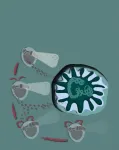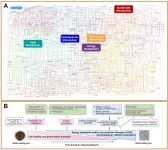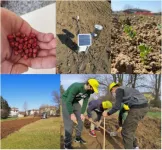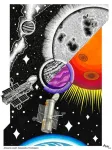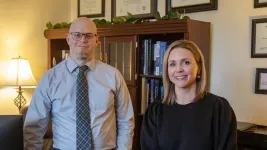(Press-News.org) A type of aggressive, treatment-resistant brain tumor has a distinct population of immune cells that support its growth, according to new research led by investigators at the Johns Hopkins Kimmel Cancer Center Bloomberg~Kimmel Institute for Cancer Immunotherapy and the Johns Hopkins University School of Medicine.
Searching for subtypes of immune cells seen only in the most serious, grade 4 brain tumors, called glioblastomas, and using a recently developed technology called spatial genomics, the researchers found that glioblastoma stem cells were co-localized with a type of immunosuppressive cell called myeloid-derived suppressor cell (MDSC), and that these two cells symbiotically feed off of each other to promote tumor growth and aggressiveness. A description of the work was published Jan. 17 in the journal Science. “Tumor stem cells represent only 5% to 10% of the tumor, but they’re the critical cells that are renewing and generating the rest of the tumor and are essentially responsible for the aggressiveness of the tumor,” says senior study author Drew Pardoll, M.D., Ph.D., the Martin D. Abeloff Professor of Cancer Research , co-director of the Mark Foundation Center for Advanced Genomics and Imaging, and director of the Bloomberg~Kimmel Institute for Cancer Immunotherapy. “We found that the myeloid-derived suppressor cells and tumor stem cells literally were in the same place — a region described by pathologists in the 1980s as the pseudopalisading region. There was a very intimate connection.”
To better characterize the cellular components of brain cancer, investigators performed single-cell RNA sequencing on tissue samples from 33 types of brain tumors spanning from low to high grade, finding two populations of MDSCs in IDH-WT glioblastoma. Then, using a technique called spatial transcriptomics to look at patterns of gene expression of over 750,000 immune cells and more than 350,000 tumor and associated cells in these samples, they found MDSCs were co-located with the tumor stem cells.
“Glioblastoma is a highly aggressive brain tumor with remarkable ability to evade the immune system, which has made immune-based therapies largely ineffective to this point,” said first and co-corresponding author, Christina Jackson, M.D., an assistant professor of neurosurgery at the Perelman School of Medicine at the University of Pennsylvania, who was at Johns Hopkins at the time the research was conducted. “Our study revealed a distinct subset of immune cells, known as myeloid-derived suppressor cells that promote glioblastoma growth, providing new insights into how the tumor interacts with the immune system. By identifying these cells and their role, we hope to uncover new therapeutic targets andlay the groundwork for more effective treatments.”
In their studies, investigators discovered that the two types of cells were feeding each other in the brain tumors. Tumor stem cells were producing chemical signals called chemokines that attracted the MDSCs, and making growth factors and activation factors for the MDSCs. In turn, the MDSCs were producing growth factors for the tumor cells.
The researchers were able to further ascertain what specific molecules tumor stem cells were producing to attract and activate MDSCs. Two of the key ones identified by the team were IL (interleukin)-6 and IL-8, which play a role in inflammatory responses, and for which MDSCs have receptors.
“IL-8 is one of the major attractants to bring the MDSCs to the tumor, and IL-6 is one of the major activators of the MDSCs,” Pardoll says.
On the flip side, the team found that MDSCs secreted a growth factor called fibroblast growth factor 11 (FGF11) to feed the stem cells, a molecule never before known to be involved in brain or other cancers.
Along the way, Jackson, Pardoll and colleagues found that tumors with a mutation in the IDH1 gene, which are less aggressive, had almost no MDSCs and far fewer cancer stem cells. This led them to look across all brain cancers at the correlation between MDSC infiltration and survival. Using the National Cancer Institute’s Cancer Genome Atlas (TCGA) database of cancer samples, they indeed found that very tight correlation — the fewer cancer stem cells and fewer MDSCs a person had in their tumors, the better they did.
While additional studies are needed to further understand these cellular interactions, the work is exciting in that it suggests additional potential targets to block in treatment of these aggressive brain tumors, Pardoll says. For example, Jamie Spangler, Ph.D., an associate professor of biomedical engineering at Johns Hopkins, has developed an investigational bispecific antibody that binds to the receptors for IL-6 and IL-8, blocking their signaling.
Study co-authors were Christopher Cherry, Sadhana Bom, Arbor Dykema, Rulin Wang, Elizabeth Thompson, Ming Zhang, Runzhe Li, Zhicheng Ji, Wenpin Hou, Wentao Zhan, Hao Zhang, John Choi, Ajay Vaghasia, Landon Hansen, Kate Jones, Fausto Rodriguez, Jon Weingart, Calixto-Hope Lucas, Jonathan Powell, Jennifer Elisseeff, Srinivasan Yegnasubramanian, Chetan Bettegowda and Hongkai Ji of Johns Hopkins. Other researchers contributing to the work were from Stanford University School of Medicine in California.
The research was supported by the National Institutes of Health (grants #F32NS108580, #R01HG010889, R01HG009518, RA37CA230400, U07CA230691), the Neurosurgery Research Education Foundation, the Bloomberg~Kimmel Institute for Cancer Immunotherapy, the Mark Foundation for Cancer Research, a Burroughs Wellcome Career Award for Medical Scientists, the Commonwealth Foundation, the Maryland Cigarette Restitution Fund and the NIH Pioneer Award.
Bettegowda is a consultant for Bionaut Labs, Privo Technologies, Haystack Oncology and Depuy-Synthes. He also is a co-founder of OrisDx and Belay Diagnostics. Yegnasubramanian has received grant support through Johns Hopkins from Bristol Myers Squibb and Janssen and grants and personal fees from Cepheid. He is a co-founder of Digital Harmonic and Brahm Astra Therapeutics. Elisseeff is founder of Aegeria Soft Tissue. Powell is an employee of Calico but was not when this research was performed. Pardoll is a consultant for Amgen, Arcturus Therapeutics, ATengen, Bristol Myers Squibb, Compugen, Dragonfly Therapeutics, Immunomic Therapeutics, Normunity, PathAI, RAPT Therapeutics, Regeneron, Takeda Pharmaceuticals and Tizona. He has received grant support through Bristol Myers Squibb, Compugen, Enara Bio and Immunomic Therapeutics, and owns stock in Dracen Pharmaceuticals, Dragonfly Therapeutics, Enara Bio, RAPT Therapeutics and Tizona. Pardoll is on the board of directors of Clasp Therapeutics and Dracen Pharmaceuticals and has patent royalties with Bristol Myers Squibb and Immunomic Therapeutics. These relationships are managed by The Johns Hopkins University in accordance with its conflict-of-interest policies.
END
Co-located cell types help drive aggressive brain tumors
2025-02-07
ELSE PRESS RELEASES FROM THIS DATE:
Social media's double-edged sword: New study links both active and passive use to rising loneliness
2025-02-07
"The Epidemic of Loneliness: A Nine-Year Longitudinal Study of the Impact of Passive and Active Social Media Use on Loneliness" investigated how social media use impacts loneliness over time. This eye-opening research suggests that the very platforms designed to bring us together contribute to an "epidemic of loneliness."
The findings showed that both passive (PSMU) and active (ASMU) social media use were associated with increased feelings of loneliness over time. While passive social media use—like browsing without ...
An unexpected mechanism regulates the immune response during parasitic infections
2025-02-07
Researchers at the University of Liège (Belgium) have uncovered a previously unknown mechanism that regulates the immune response against parasites. During a parasitic infection, specific immune cells, known as virtual memory T cells (TVM), become activated and express a surface molecule called CD22, which prevents an excessive immune reaction. This discovery could help in better-controlling inflammation and improving immune responses to infections.
Nearly a quarter of the world's population ...
Scientists enhance understanding of dinoflagellate cyst dormancy
2025-02-07
Dinoflagellates play crucial roles in aquatic ecosystems, particularly as major contributors to harmful algal blooms. They can enter a dormant stage, known as the resting cyst stage, that allows them to survive for extended periods—up to 150 years—in marine sediments. This dormancy is essential for their annual population dynamics, blooming cycles, and geographic expansion.
Despite the ecological importance of resting cysts, the molecular mechanisms governing their dormancy, viability maintenance, and germination in natural sediments remain largely unexplored.
To better understand this process, researchers from the Institute of Oceanology, Chinese Academy of Sciences ...
PREPSOIL promotes soil literacy through education
2025-02-07
One of the eight key aims of the EU Mission Soil is to enhance soil literacy in society. As part of this effort, the PREPSOIL project is working to inspire teachers across Europe to integrate soil topics into their teaching. By identifying and promoting innovative examples of soil education, PREPSOIL aims to empower educators to engage students in exploring the vital role of soil in natural, urban, and agricultural environments.
In 2023 and 2024, teachers were invited to submit their best practices in soil education targeting primary, secondary, and vocational students. The initiative received over 50 submissions, showcasing a variety of creative and interdisciplinary ...
nTIDE February 2025 Jobs Report: Labor force participation rate for people with disabilities hits an all-time high
2025-02-07
East Hanover, NJ – February 7, 2024 – The latest National Trends in Disability Employment (nTIDE) report revealed a record-breaking Labor Force Participation Rate for people with disabilities, marking an all-time high. These gains build upon a steady upward trend, which exceeded those seen among people without disabilities. nTIDE is issued by Kessler Foundation and the University of New Hampshire’s Institute on Disability (UNH-IOD).
Month-to-Month nTIDE Numbers (comparing December 2024 to January 2025)
Based on data from the ...
Temperamental stars are distorting our view of distant planets
2025-02-07
Most of the information we have about planets beyond our solar system (exoplanets) comes from looking at dips in starlight as these planets pass in front of their host star.
This technique can give clues about the planet’s size (by looking at how much starlight is blocked) and what its atmosphere is made of (by looking at how the planet changes the pattern of starlight that passes through it).
But a new study, published in The Astrophysical Journal Supplement Series, concluded that fluctuations in ...
DOE’s Office of Science is now Accepting Applications for Office of Science Graduate Student Research Awards
2025-02-07
Washington, D.C. – The U.S. Department of Energy’s (DOE) Office of Science is pleased to announce that the Office of Science Graduate Student Research (SCGSR) program is now accepting applications for the 2025 solicitation 1 cycle. Applications are due on Wednesday, May 7, 2025, at 5:00 p.m. ET.
SCGSR application assistance workshops will be held on March 6, 2025, 2:00 p.m.–3:30 p.m. ET and April 10, 2025, 2:00 p.m.–4:30 p.m. ET. The first workshop ...
Twenty years on, biodiversity struggles to take root in restored wetlands
2025-02-07
While the restoration of natural areas is high on political agendas, a comprehensive new study from the University of Copenhagen shows that – after more than two decades – biodiversity growth has stalled in restored Danish wetlands. The results also suggest that time alone will not heal things because the areas are too small and dry, and nitrogen inputs from agriculture continue. According to the researchers, we need to learn from the past.
The benefits are clear: natural areas with high biodiversity absorb ...
Do embedded counseling services in veterinary education work? A new study says “yes.”
2025-02-07
COLUMBIA, Mo. -- Embedded counseling services are becoming increasingly common in veterinary medical programs, but their effectiveness has not historically been measured. A new study by University of Missouri researchers revealed that these programs may not only enhance access to mental health care but also lead to significant reductions in psychological distress among veterinary trainees.
“It’s the first study, as far as we know, to evaluate the effectiveness of mental health counseling for veterinary trainees,” said Kerry Karaffa, PhD, a licensed psychologist at the ...
Discovery of unexpected collagen structure could ‘reshape biomedical research’
2025-02-07
Collagen, the body’s most abundant protein, has long been viewed as a predictable structural component of tissues. However, a new study led by Rice University’s Jeffrey Hartgerink and Tracy Yu, in collaboration with Mark Kreutzberger and Edward Egelman at the University of Virginia (UVA), challenges that notion, revealing an unexpected confirmation in collagen structure that could reshape biomedical research.
The researchers used advanced cryo-electron microscopy (cryo-EM) to determine the atomic structure of a packed collagen assembly that deviates from the traditionally accepted right-handed superhelical twist. ...
